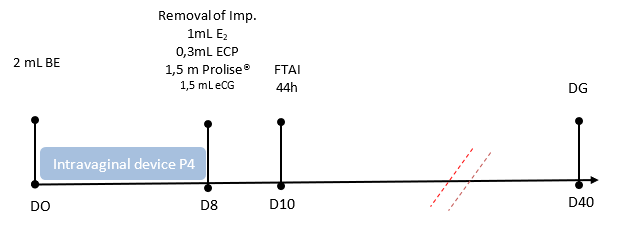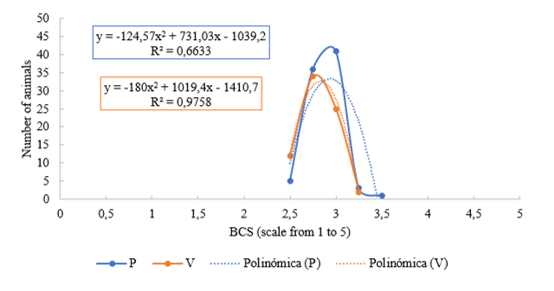Introduction
Cuntless strategies have been widely used, aiming at an adequate nutritional and reproductive management, in which the maximum use of all the genetic potential of the animals is aimed 1. Brazil has a bovine herd with more than 193.4 billion animals (Instituto Brasileiro de Geografia e Estatistica - IBGE) 2, about 95% of which are raised in an extensive system, where the pasture undergoes great quantitative and qualitative variation throughout the year, which is one of the main factors that affect the body condition and weight of the animals 3 interfering with the productive and reproductive efficiency of bovine females destined for meat production 4.
The introduction of an adequate nutritional management takes on a fundamental role. The body condition score (BCS) is a subjective measure, based on the classification of animals according to muscle mass and fat coverage, through a visual and/or tactile assessment, being considered an easy and inexpensive method, and provides a sufficiently reliable estimate of body energy reserves in Bos indicus cows 5,6. BCS influences production, affecting calf weight at weaning, and reproduction, affecting pregnancy rate 7,8,9.
Regarding reproductive management, fixed-time artificial insemination (FTAI) has been increasingly used 10,11,12,13,14. This biotechnique aims to synchronize the ovulation of bovine females after the administration of drugs on predetermined days, so that it is possible to synchronize a batch of cows and inseminate them on the same day, without the need for estrus observation 15,16,17,18.
Based on this information, this study aimed to assess whether there is a correlation between the BCS and the pregnancy rate of cows submitted to FTAI on Ilha do Marajó, Pará, in the Eastern Amazon.
Material and methods
Animals and experimental location
A total of 159 female Nellore (Bos taurus indicus) cattle, aged 5 years and average weight of 350 ± 19.5 kg, were used. The experiment was carried out from April to July 2020, on a rural property in the municipality of Cachoeira do Arari, on Ilha Marajó, Pará state. The climate of the municipality is classified as Ami according to Köppen and Geiger 19, with an average temperature of 27.3 °C and an average annual rainfall of 2,369 mm.
Experimental design
The females were selected through clinical and gynecological evaluation, being considered clinically healthy and cyclic cows. The body condition score (BCS) of each animal was also evaluated, as described by Ayres et al.5 and Torres et al.20 (1 very thin .... 5 obese). All females were raised in an extensive system, with grasses native to the region, such as canarana-erecta-lisa (Echinochloa pyramidalis), taboquinha (Panicum laxum), Andrequicé (Leersia hexandra), goat's beard (Aristida longiseta) and mineral salt and with access to water ad libitum. Regarding sanitary management, all cows were inoculated against foot-and-mouth disease and brucellosis.
Hormonal protocol
After selection, the cows were submitted to the hormonal protocol and FTAI. The hormonal protocol lasted 10 days and was divided into four stages (Day 0 - D0, Day 8 - D8, Day 10 - D10 and Diagnosis of Pregnancy - DG), being used on D0 intravaginal progesterone implant (PRIMIER®) associated to estradiol benzoate (Ric-be® - 2 mL), as described below. On D8, the P4 Implant was removed + 1 mL of Ric-be® + 0.3 mL of ECP® + 1.5 mL of Prolise® + marking of the females with a stick ink in the sacral region. On day 10, FTAI was performed 44 h after implant removal, where semen from three bulls was used, two of the Angus breed and one of the Nelore breed, being used randomly in each animal, previously chosen by the person responsible for the animals. On D10, Fixed-Time Artificial Insemination (FTAI) was performed (Figure 1).

Figure 1 Schematic drawing of the established artificial insemination protocol. E2 = estrogen; ECP = Estradiol Cypionate; FTAI = fixed-time artificial insemination; PD = pregnancy diagnosis.
The pregnancy diagnosis was done by using ultrasound (Mindray®, DP-10 VET), 30 days after the FTAI, and the presence of a viable embryo with a heartbeat indicated pregnancy.
Pregnancy rate
The pregnancy rate was calculated based on the following formula:
PR = NP/NCS
On what:
PR = Pregnancy rate; NP = number of pregnant cows; NCS = number of cows studied.
Statistical analysis
Data were organized in Microsoft Office® Excel 2018 spreadsheets. Descriptive statistics were performed using the software R version 16.8, as well as Pearson's correlation by biserial point at 5% significance.
Results and discussion
Of the 159 females submitted to FTAI, 86 had a positive pregnancy diagnosis, obtaining a pregnancy rate of 54.08% and the number of empty females was 73, that is, 45.92%. There was a positive (r = 0.167) and significant correlation between BCS and pregnancy rate (p<0.05) (Table 1). This can be explained as a result of the greater accumulation of lipids in cows, and, consequently, a greater energy reserve, which are described as guarantees of the animal's body metabolism, which favors the secretion of hormones that make up the hypothalamic-pituitary axis, promoting the release of gonadotropin-releasing hormone (GnRH) by the hypothalamus and the production of follicle-stimulating hormone (FSH) and luteinizing hormone (LH) by the anterior pituitary, which are important in follicular growth and ovulation (21, 22). Thus, when the FTAI is performed on females with an ECC greater than 2.75, the efficiency of the technique becomes more accurate and the financial gains are greater 23.
Table 1 Pearson's correlation between BCS and Pregnancy variables in Nelore cows, Cachoeira de Arari, Marajó, Pará, Brazil.

Note: p<0,05 indicates statistical difference. ** positive correlation. NE = not evaluated
Moretto et al.24, Bryk Filho et al.25 warn that the nutritional status directly affects the reproductive indices of the herd. Furthermore, BCS directly influence the pregnancy rate of animals raised in an extensive system, as they tend to reduce cyclicity, as described by Michael et al., 26. This fact was evidenced in the cows of the present study, as the empty cows had lower body score indexes than the pregnant animals.
Bovine females that presented an ECC greater than 2.75 (scale from 1 to 5) had better pregnancy rates (Figure 2). Therefore, the nutritional condition of the females affected the pregnancy rate in the herd studied. These results support what was described by Valle et al.27, Meneghetti; Vasconcelos, 28 and Costa et al.29. Some authors point out that a good body condition score influences pregnancy rates in cows submitted to FTAI 22,23,30,31,32.

Figure 2 Linear regression of BCS according to the number of pregnant and empty animals. E = empty; P = pregnancy.
In this study, cows with BCS ≤2.75 had a higher rate of empty cows, that is, 5.74% more cows submitted to FTAI did not develop pregnancy. When the BCS was >2.75, the cows had a pregnancy rate 25% higher than the number of empty cows.
Corroborating the results obtained in this study, Brondani et al. 33 found that cows with BCS ≥2.75 had better pregnancy rates. Carvalho et al.34 also state that females with an ECC between 3 and 3.5 had better pregnancy rates, with 59.4% and 54.8%, respectively. Torres et al.20 point out that an increase of 0.5 units in the BCS can provide a 39% increase in the possibility of pregnancy.
With similar results to the present study, Santos et al. 35 and Sonohata et al. 36 also describe that the ECC is linked to the pregnancy rate, and it is observed that females tend to have better conception rates with adequate ECC.
With results close to those observed in the present study. Bo et al.37 and Vale et al.31 showed that cows with BCS >2.5 showed better response rates to hormonal treatment and pregnancy rate. Baruselli et al.21 pointed out that Nelores cows with BCS lower than 3.0 had low conception rates. Monteiro and Viana 38 describe better pregnancy rate indices in cows with an BCS greater than 2.5. Contrary to the results achieved in this study, Meneguetthi et al.28 showed that there was no influence of the BCS on the pregnancy rate in Nellore females.
Conclusion
It is concluded that there was a positive correlation between the BCS and the pregnancy rate, with an effect of body condition on the pregnancy rate in cows raised in the Eastern Amazon, and, therefore, the nutritional status of the females at the moment should be taken of the hormonal protocol and the FTAI.















